Product release notes can be a powerful tool, but only if you approach them with the care they deserve.
They can educate both your customers and your team about the product and its features, support your marketing efforts, and strengthen the reputation of your company.
Release notes can do all that and more, but creating such a highly useful resource takes a lot of effort.
You might be wondering where to even begin. Well, you can start by looking at some of the finest examples of product release notes in the industry.
Archbee
Archbee, a documentation platform and knowledge management software, includes some practical elements in its release notes that ensure the users get all the information about the changes to their products hassle-free.
The first of those elements is a subscription to updates.
When you land on the release notes page, Archbee offers to send you notifications when they release updates to their product.
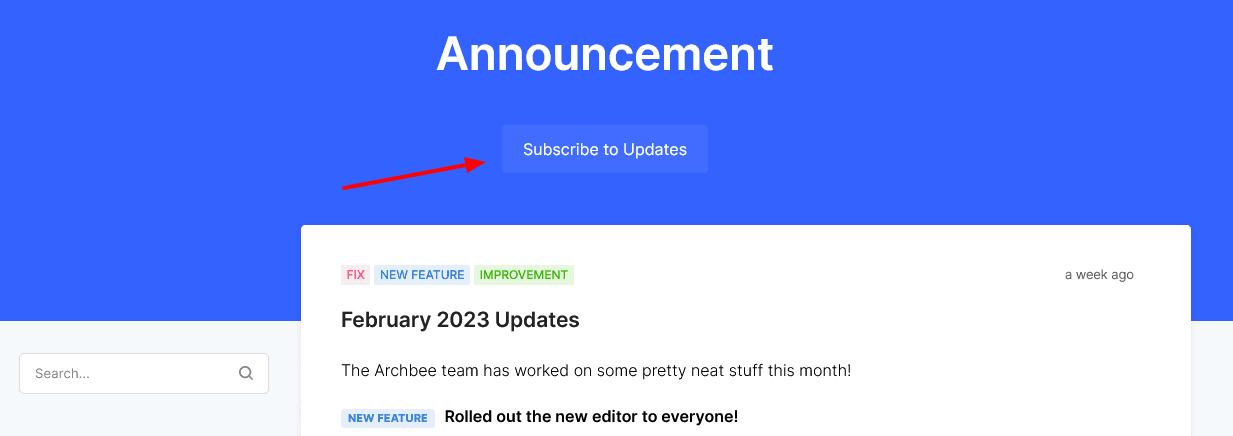
Source: Archbee
If you subscribe to their updates, you can choose between two ways of receiving them.
You can either get them delivered to your email inbox, or receive them via the RSS, Atom, or JSON feed.
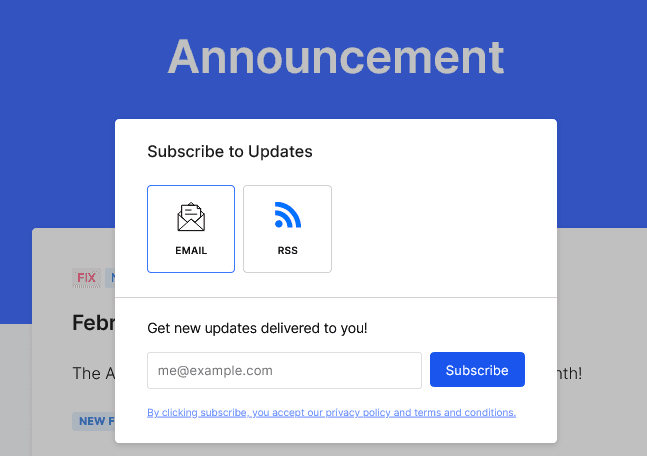
Source: Archbee
The option to subscribe is helpful both for Archbee and for the users.
When a user subscribes to the updates, Archbee’s team can be sure that they’ll be informed about every change as soon as it’s released.
That’s great for the company because it helps retain customers—if users are in the loop about new features, they can regularly find new value in the product.
On the other hand, a subscription is convenient for users because they don’t even need to check the release notes page to get new information.
Checking their email inbox, which most of us do multiple times a day anyway, is all it takes.
However, when users want to catch up on updates on the release notes page itself, the color-coding system makes processing information easier.
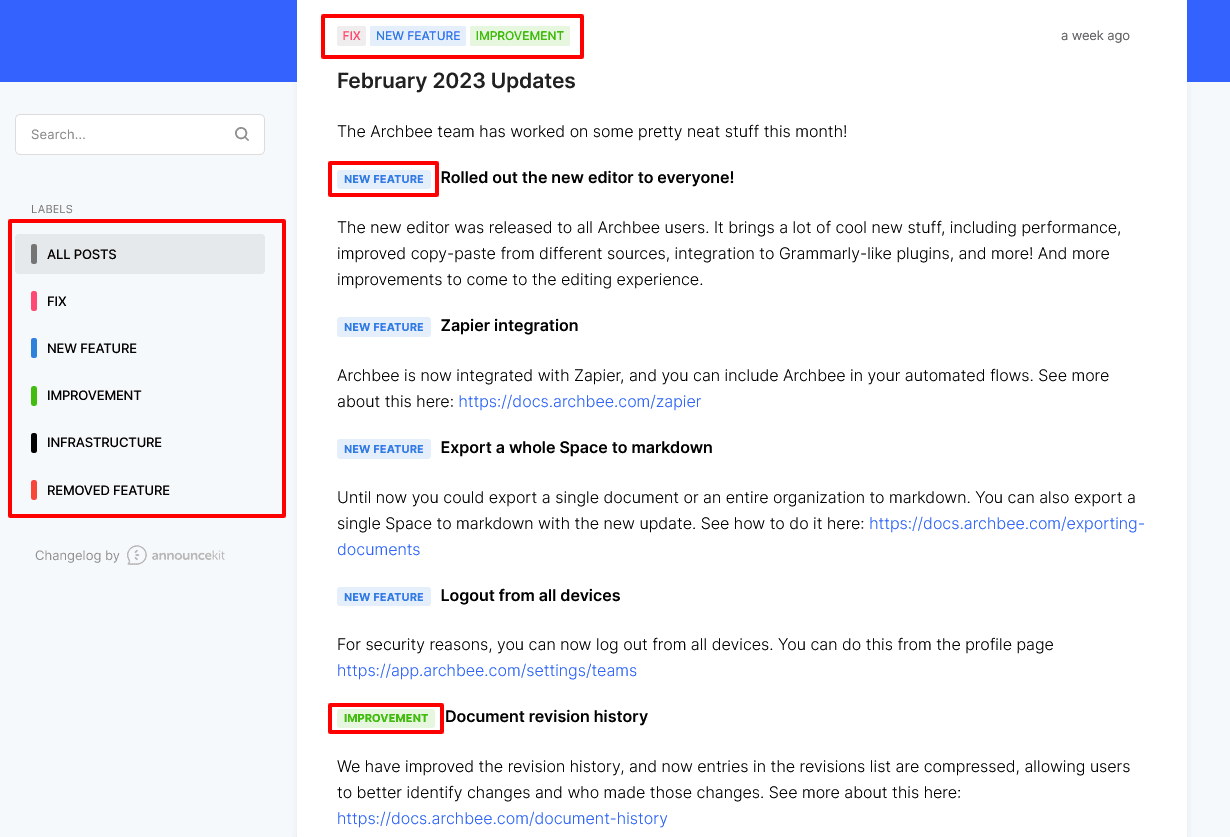
Source: Archbee
As you can see above, Archbee labels the release notes with different colors.
There are six different labels and six colors, so it's easy to see whether a release note concerns, for instance, a new feature or an improvement to an existing one, even if you’re just scrolling down the page.
And if you need to find something specific in Archbee’s release notes, like information about the Jira integration, you can use the search bar located above the color labels.
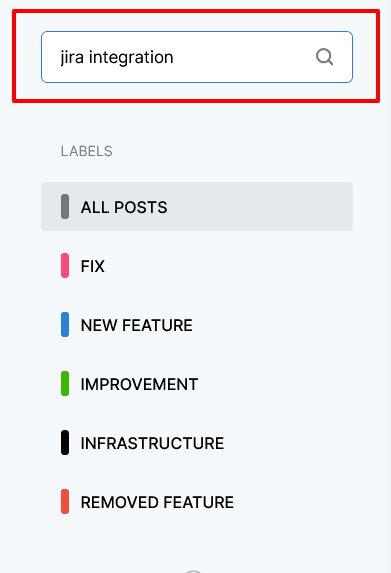
Source: Archbee
You’ll then get all the results that match your search query so you can easily find the information you need.
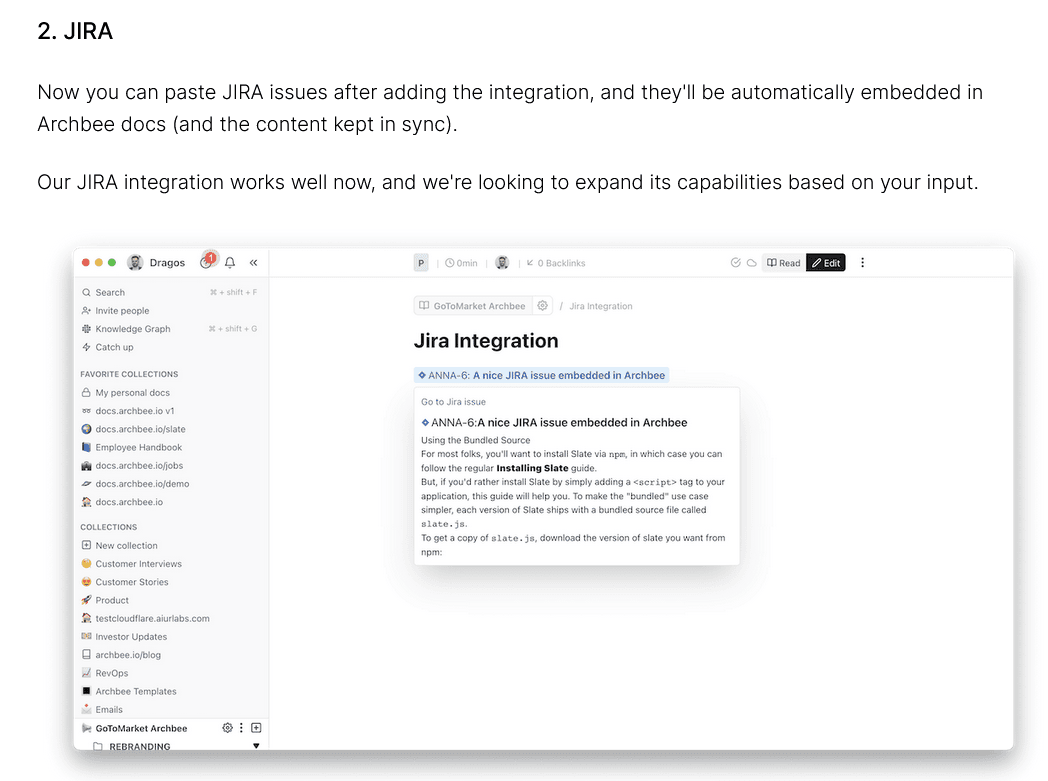
Source: Archbee
As we’ve mentioned earlier, Archbee is a documentation platform, so it offers dozens of features you can use to create your docs.
That also includes creating and publishing release notes for your product.
For instance, ChartHop uses Archbee to publish release notes, and they use some of Archbee’s practical features, like a sidebar navigation panel for easy navigation or an option to switch between light and dark mode.
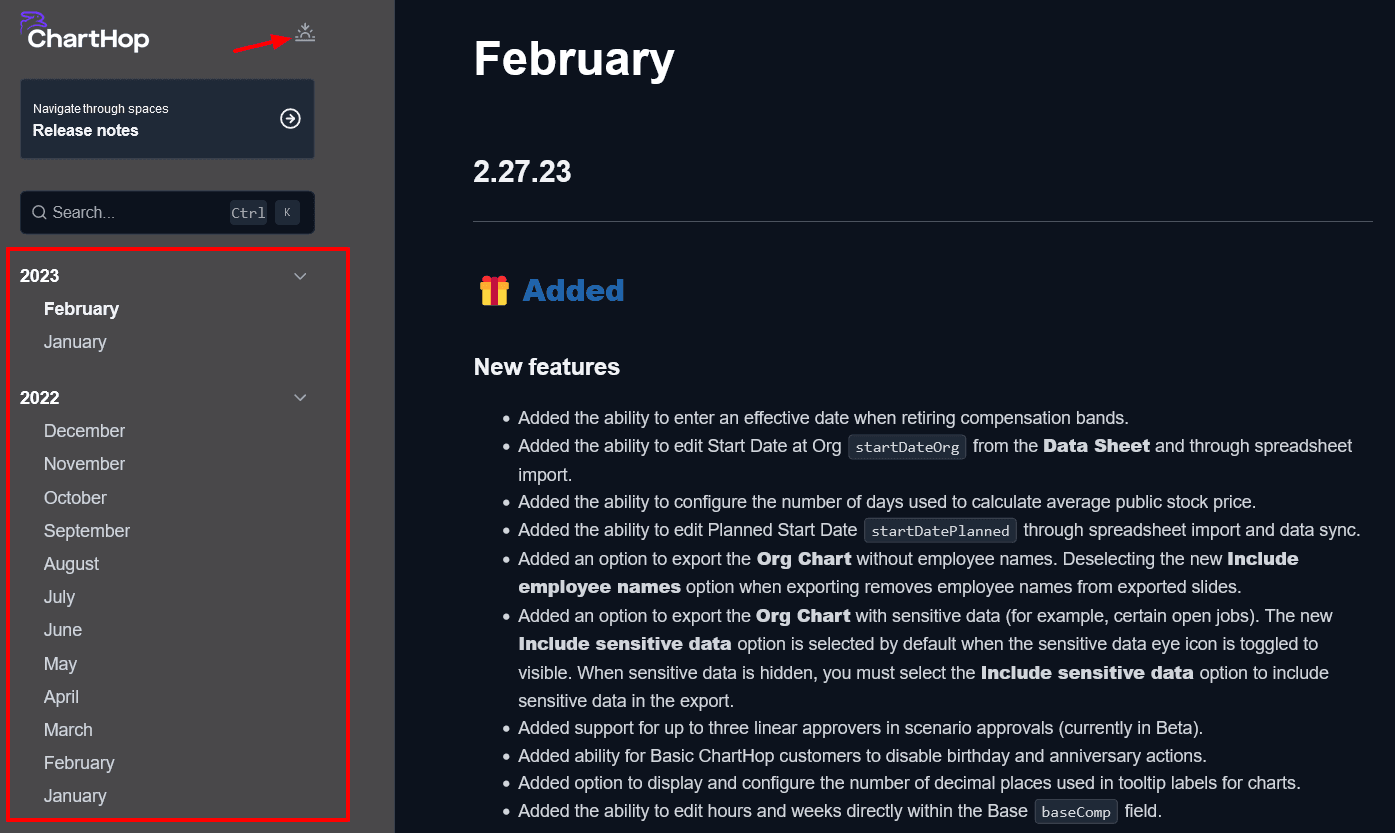
Source: ChartHop
Archbee’s release notes provide some simple but effective features you can take inspiration in.
Offering the possibility to subscribe to updates, as well as providing color labeling, and easy search and navigation, can elevate your release notes to a new level of usefulness.
Asana
Concise and easy-to-understand release notes are what most users want, and if you can provide that, they’ll be quite satisfied.
However, you can go a step further, like the work management platform Asana does when compiling their release notes.
What sets Asana’s release notes apart is their use of media—more specifically, videos.
Asana publishes its product release notes once a month, and they have essentially the same structure every time.
At the start, you can watch a brief, minute-long video that presents the most significant changes made to the product in a particular month.
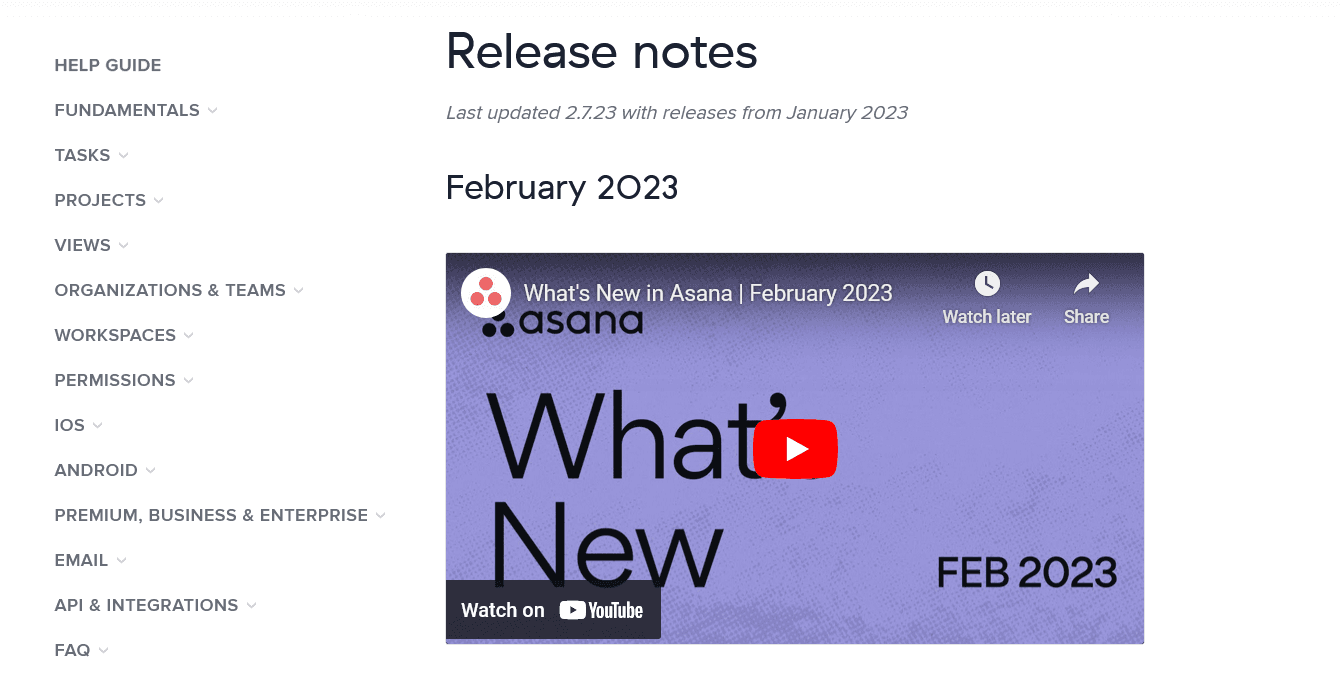
Source: Asana
The use of video is an excellent way to relay information to customers.
Instead of presenting them with a wall of text that, most likely, not all of them will have the time or the willingness to read, Asana’s team informs customers about the essential changes, updates, and fixes efficiently through a visual medium.
In addition to their information value, the videos are dynamic and colorful, which their users can recognize as a great fit for Asana’s style and brand.
Of course, videos are just one part of Asana’s release notes. Below each video, they present changes in the form of a bulleted list, which includes links to relevant help articles.
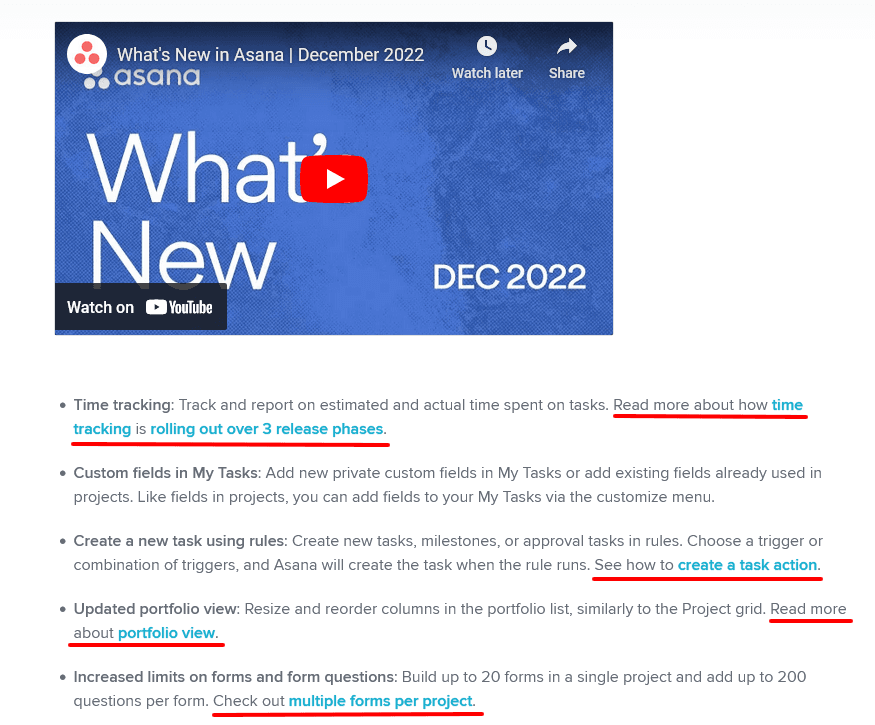
Source: Asana
Therefore, in addition to a bulleted list, widely regarded as an efficient format for organizing and presenting information in its own right, Asana’s team also packs it with links to valuable knowledge.
For example, above, you can see that a section of their December 2022 release notes included information about an updated portfolio view.
Instead of going into details about what a portfolio view is and how to access and use it, they simply included a link to an article about it in their knowledge base.
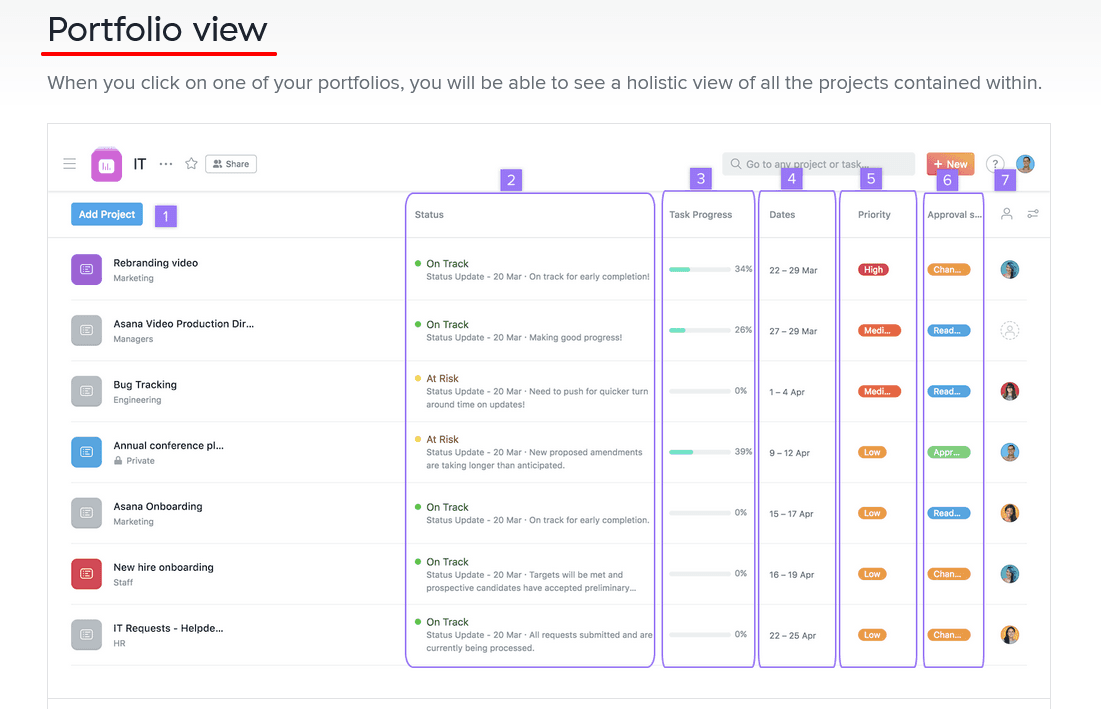
Source: Asana
By doing that, they successfully limited the information in their release notes only to the essentials, but also provided a way for their users to learn more about a certain topic.
The efficiency of Asana’s approach to product release notes, including the use of videos, is an excellent model you can use to shape your own resources.
Confluence
Product release notes need to be easy to use and efficient in conveying information, first and foremost.
Confluence’s release notes stick to those principles and add functionalities to simplify their users’ lives.
This collaboration software tool has a simple layout for its release notes.
Their team presents the main points in their release notes and leaves it up to every customer to read and learn more about particular changes or the process behind them.
As you can see below, there’s a “More details” section that you can click on for that purpose.
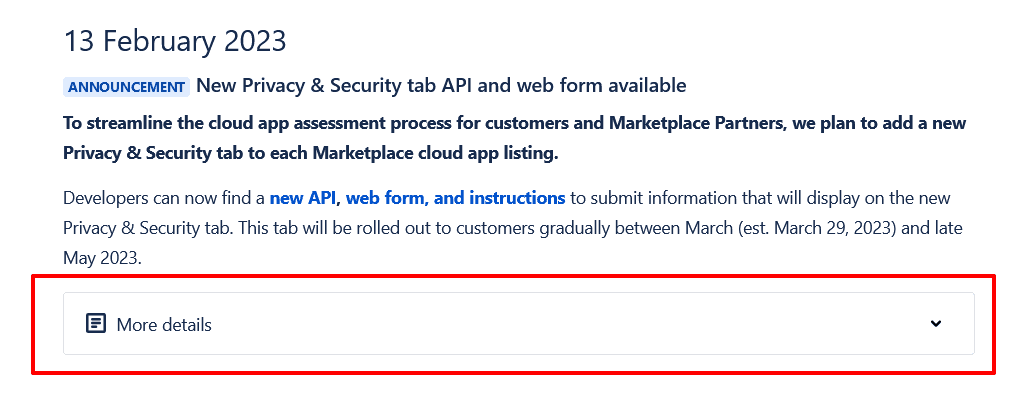
Source: Confluence
If you click on it, a window will open with more context about a change that is only briefly explained in the text above the field.
The additional text also doesn’t overwhelm readers with details. There are usually multiple links in it that readers can follow for more information if they’re curious.
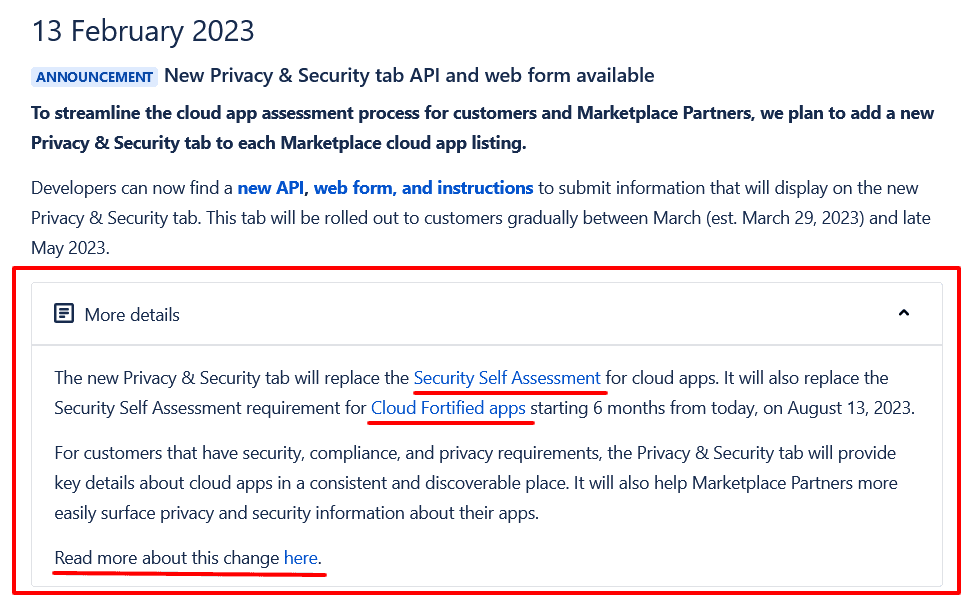
Source: Confluence
In general, Confluence’s product release notes are rich with links to other resources.
That fits in with efficiency as one of the main characteristics of their release notes.
For example, you can see below how typical release notes look on their page.
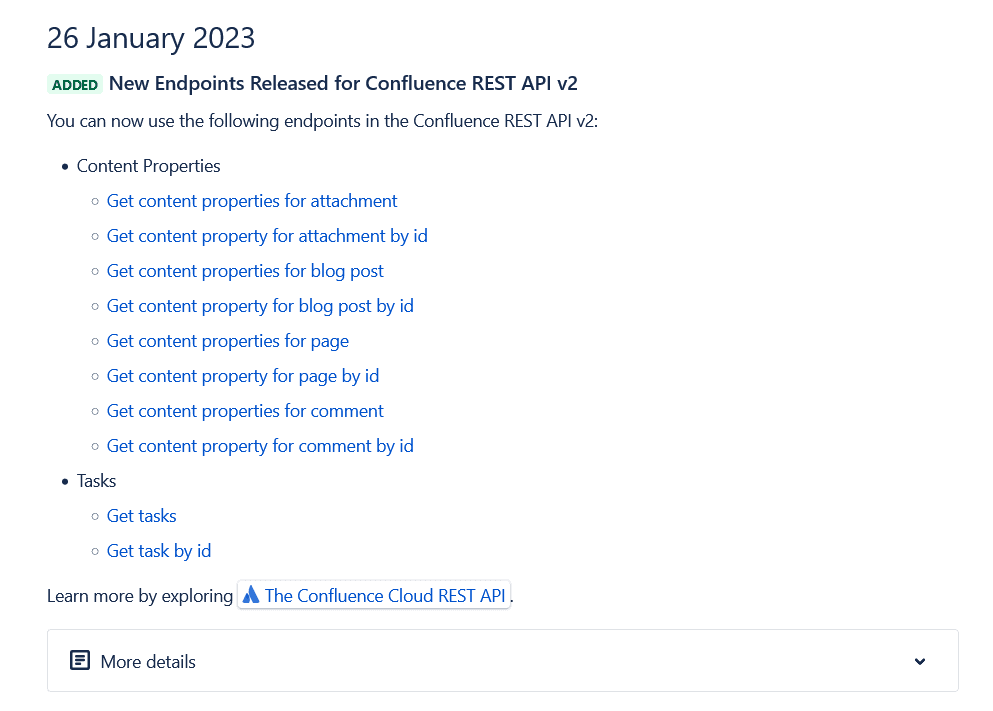
Source: Confluence
There are no detailed explanations, embellished language, or attempts at humor—only pure information with additional resources for those interested.
Confluence’s release notes have got you covered if you also want to search for something specific.
At the top of the page, there’s an option to filter notes by several categories.
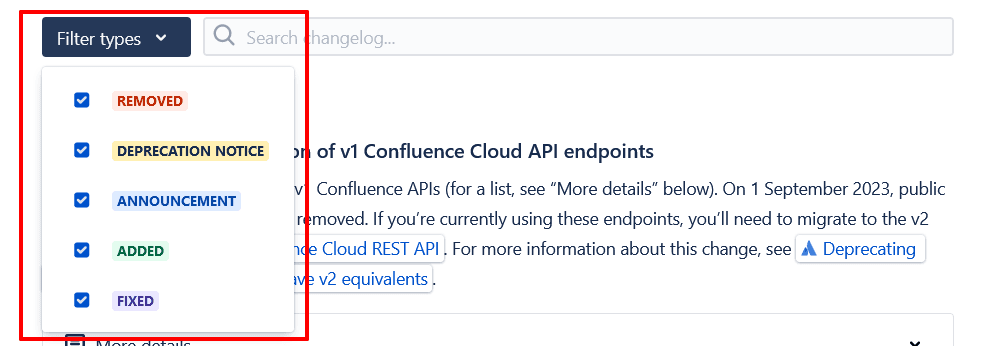
Source: Confluence
Combining filtering with the search bar next to the filter feature lets you quickly and efficiently narrow down the search results.
For example, if you want to read only about added APIs and those with deprecation notices, you can check those two categories and search for the desired term.
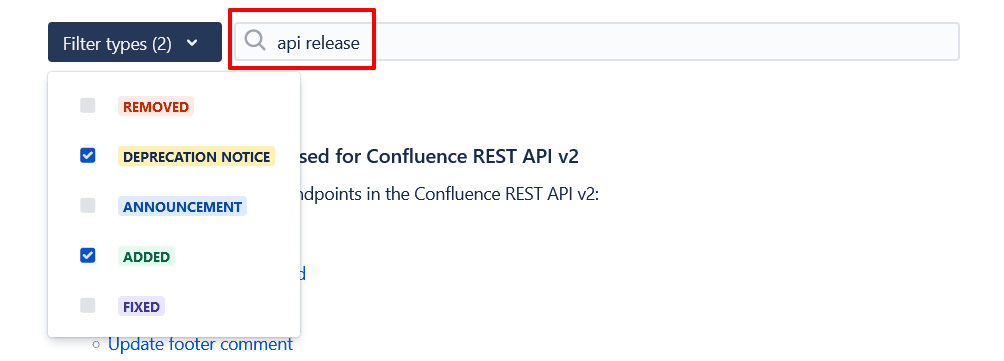
Source: Confluence
The search function will provide real-time results as you type into the search bar.
Product release notes with a simple design and helpful features are focused on one thing—providing readers with the necessary information and doing it quickly.
Confluence managed to achieve precisely that.
GitHub
It’s a challenging task to create release notes with instantly recognizable design, excellent functionality, and top-notch attention to detail.
However, GitHub managed to create such a resource.
The first thing you’ll most likely notice when you visit their product release notes page is the design.
GitHub’s team divided the page into two columns. On the left-hand side, there are the title, date, and tags of a release note, and on the right-hand side, there is the content.
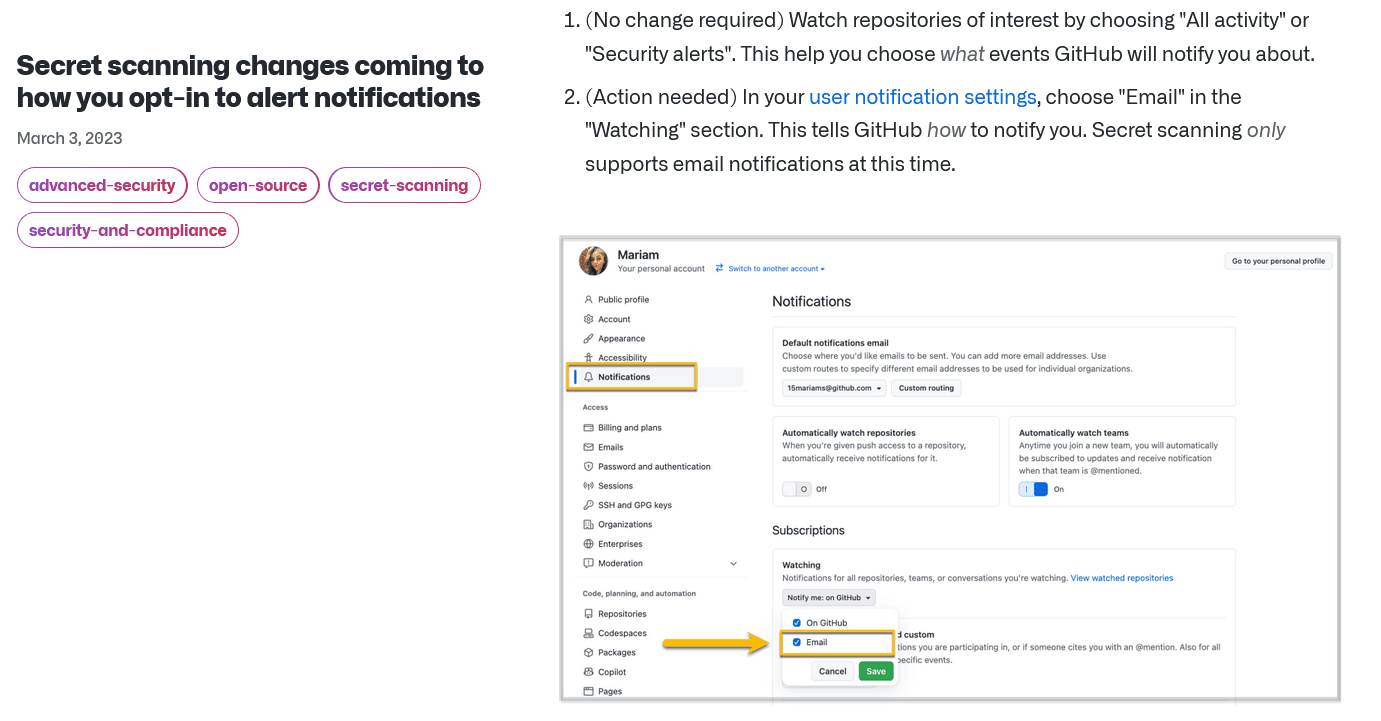
Source: GitHub
Also, as you can see above, GitHub uses a variety of visuals in its release notes.
The text is often accompanied by annotated screenshots and GIFs, making the release notes more understandable and easy on the eyes.
We’ve mentioned tags a few sentences before this one—they are another unique element of GitHub’s release notes.
Some of the release notes examples we’ve examined earlier in this article grouped notes in several categories. GitHub takes a similar approach but swaps categories with tags.
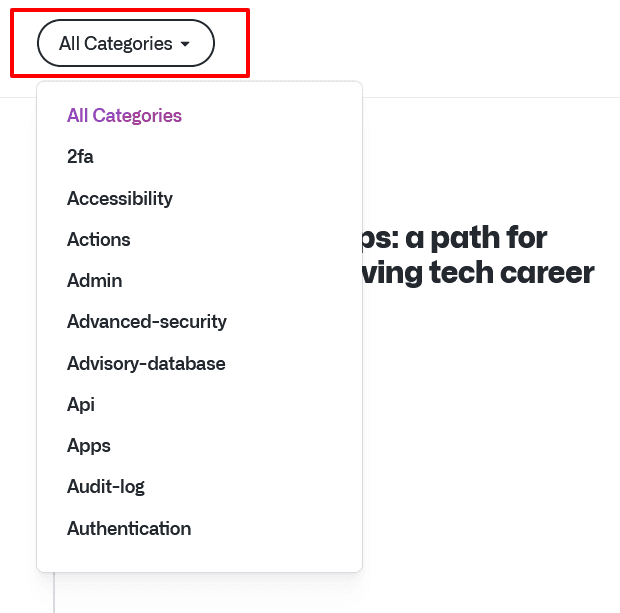
Source: GitHub
The drop-down menu with tags is at the top of the release notes page.
The biggest difference between regular categories and GitHub’s tags is that there are many more of the latter—more precisely, GitHub has included 75 tags at this point.
In other words, the segmentation of release notes is very finely tuned, and you can filter them with great precision.
Most release notes have several tags attached to them, as you can see in the example below.
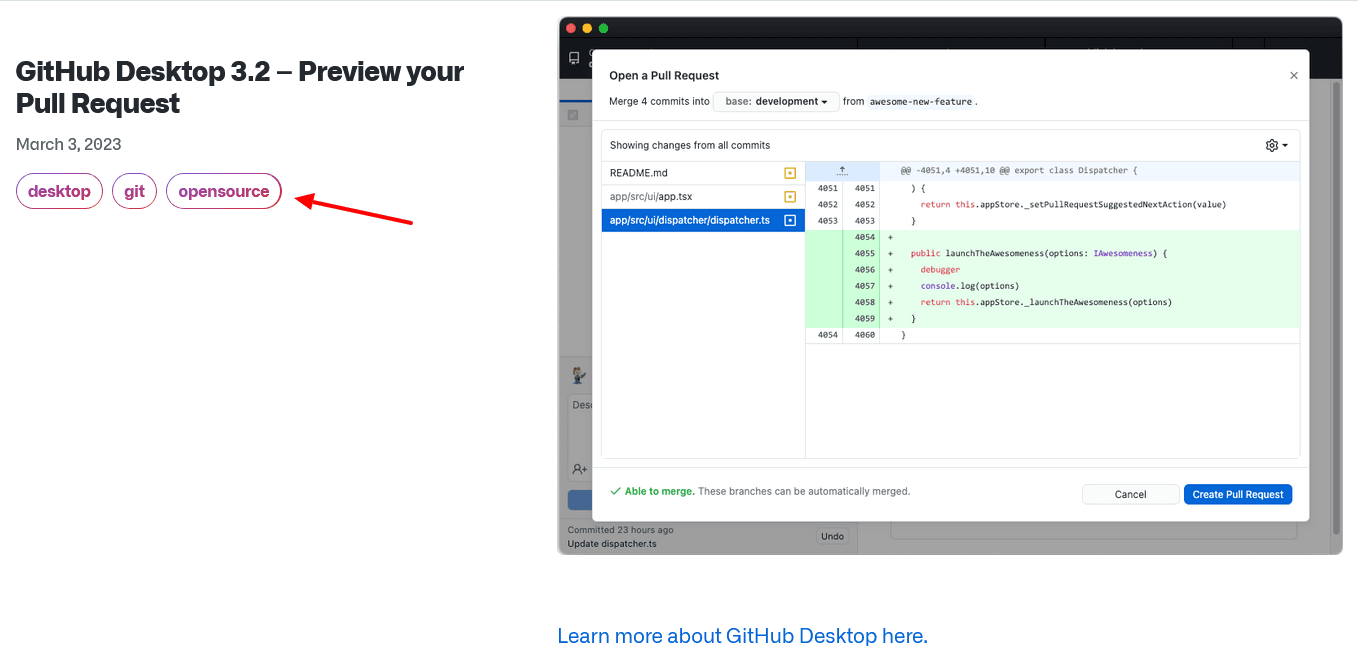
Source: GitHub
And that kind of precise segmentation is very helpful in GitHub’s release notes—because there are a lot of them.
It’s not uncommon for GitHub’s team to release notes several times a day, multiple days in a row.
For example, on March 1, they released six notes, each describing a different change to the product.
Below, you can see three of those six notes.
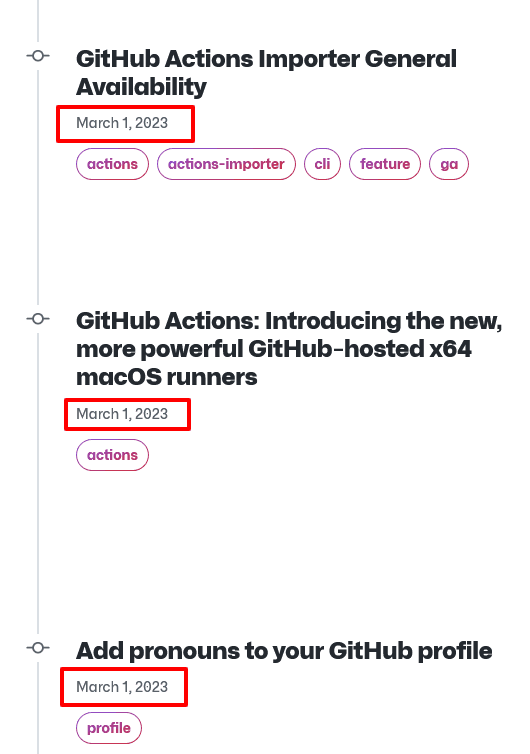
Source: GitHub
They followed that with two release notes the next day and two more the day after.
The point is that GitHub publishes a lot of release notes, so a system for precise filtering is undoubtedly useful for their users when they want to find something in that amount of content.
Detailed information about every product change on an aesthetically pleasing webpage with excellent filtering features describes GitHub’s release notes in a nutshell.
You’d do well to take inspiration from them.
Jira
Similarly to the release notes of another Atlassian product we’ve examined earlier, Confluence, Jira’s release notes are well-organized and efficient in providing information.
However, they have notable features that set them apart and make an inspiring example on their own.
When you land on Jira’s release notes page, one of the first things you’ll notice is a blue text box that offers to keep you updated with the latest changes.

Source: Jira
You can do that by logging in and clicking the watch button in the top-right corner of the page.
That will activate notifications, so you’ll receive one any time Jira publishes a new release note.

Source: Jira
That way, Jira’s team ensures that the users of their work management tool are always aware of the latest changes, new features, and other important information.
They also ensure that by announcing upcoming releases so that the users can plan and prepare for the new versions of the software.
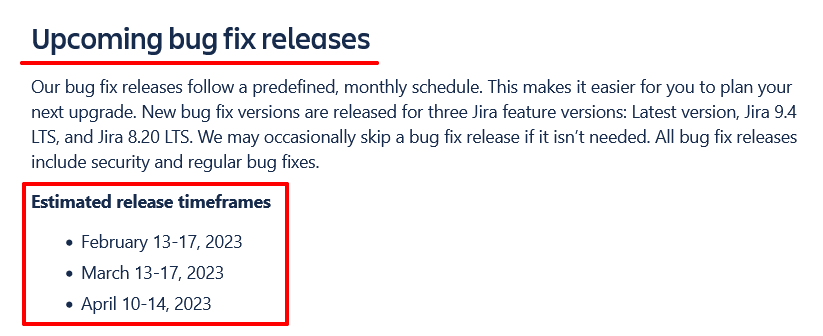
Source: Jira
And once those estimated dates come and Jira’s team publishes planned release notes, you can access those notes in two ways.
First, you can look them up on the main page, where there’s a long list of published release notes.
The other way is through an upgrade matrix, a design solution that simplifies finding the version of release notes you need.
How? By providing a quick summary of every version, a link to full release notes, and all of that in a practical and clear table format.
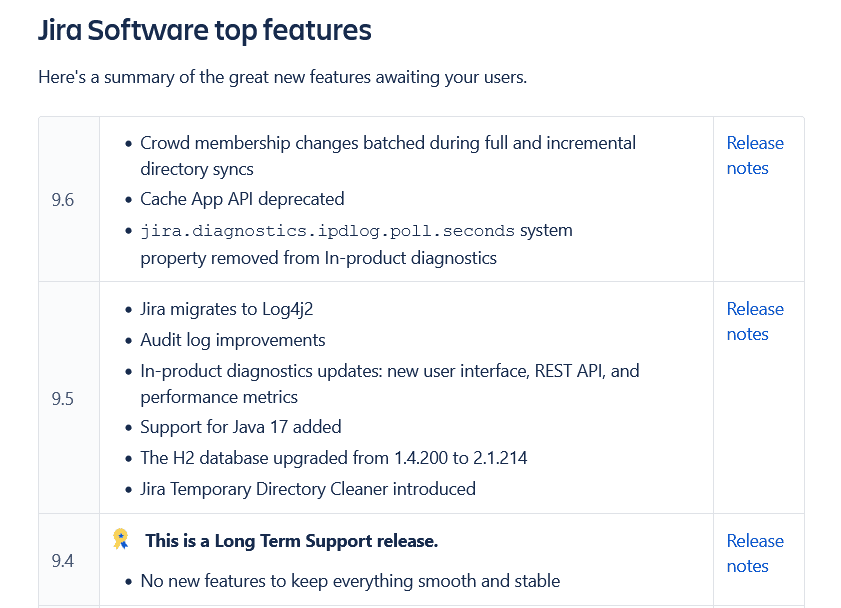
Source: Jira
An upgrade matrix is a simple yet effective way to present a lot of information in a manageable way.
The main features and changes are provided as a bulleted list, with release notes version number on the left-hand side and a link to the full document on the right-hand side.
If you access the full version of the document, the principle of efficiency and conciseness continues there as you’re presented with the highlights in the form of links to every topic.
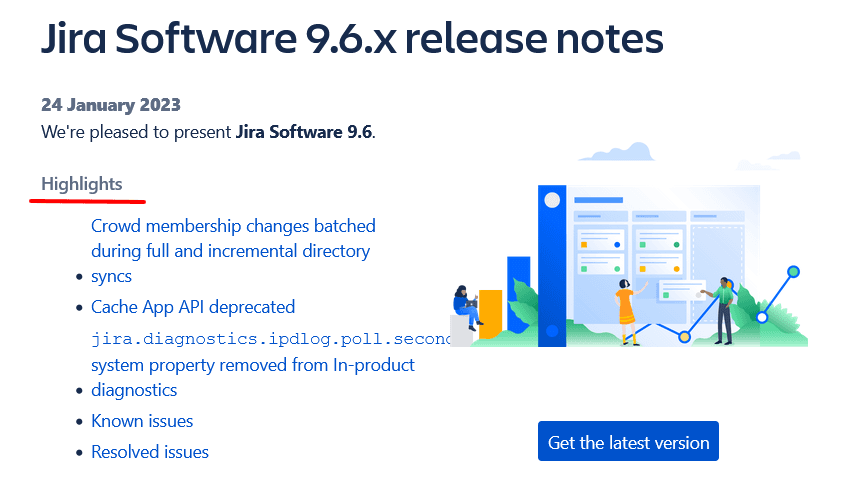
Source: Jira
That way, the reader can read only what interests them with one click of a button instead of scrolling through the whole page to the desired topic.
Jira’s product release notes aim to inform the users about every change to the product on time, and do it in a structured and efficient way.
Those characteristics can benefit any product release notes, so it would be wise to take notice.
Zoom
Zoom, a well-known communications platform, embraces a minimalistic approach when it comes to the design of its product release notes.
Zoom’s release notes aren’t particularly visually memorable, but the most important thing is that they deliver the necessary information, which they do in great detail.
What is different about Zoom’s release notes?
Well, categorization is one of their most distinctive elements—which is important when the amount of information you want to convey is substantial.
Zoom’s team categorizes release notes by date and by product.
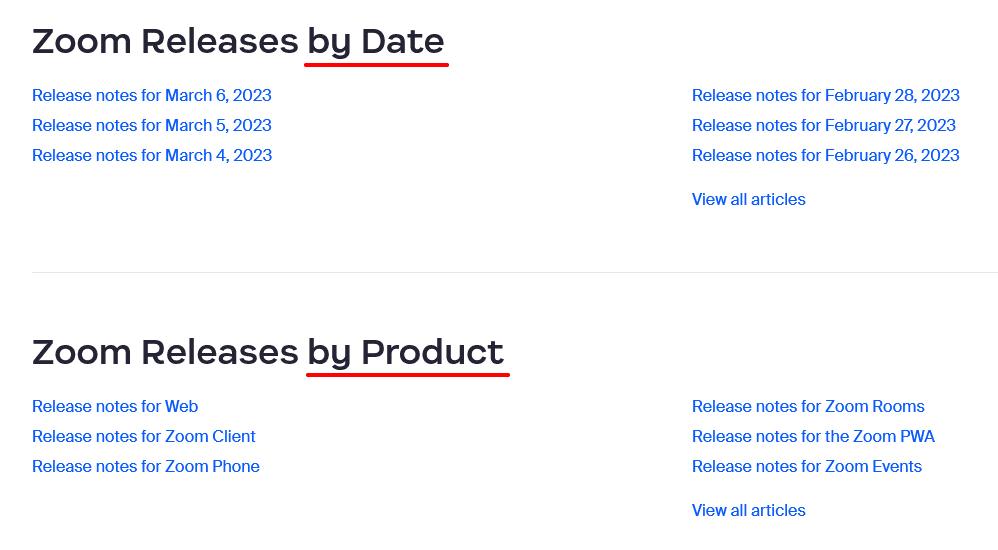
Source: Zoom
That gives the customers a choice, which is welcomed since Zoom publishes its release notes very often, and they also have multiple products on their platform.
Dividing the notes in two ways like this minimizes the potential of overwhelming the readers with documentation.
Zoom’s team also provided their users with a way to navigate through the notes themselves easily.
For example, when you open one, you can see a bulleted list of links that transport you to the specific part of the document.
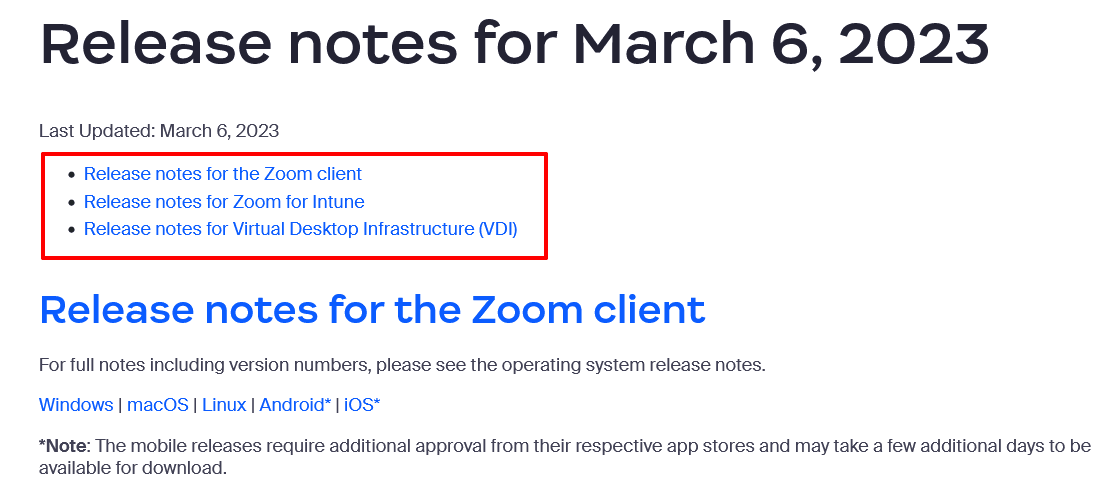
Source: Zoom
Navigation is important for making sure documentation is easy to use.
By providing readers links to parts of the document, as well as links to other related documents, you ensure that they find what they need quickly and stay informed about your product.
It’s clear that Zoom’s team is well aware of the importance of navigation since they also included links to related articles in the sidebar.

Source: Zoom
Those related articles aren’t only other release notes. In some cases, links lead to articles in Zoom’s knowledge base.
For instance, in the screenshot above, you can go from the release notes for February 28 to a help article about updating Zoom to the latest version.
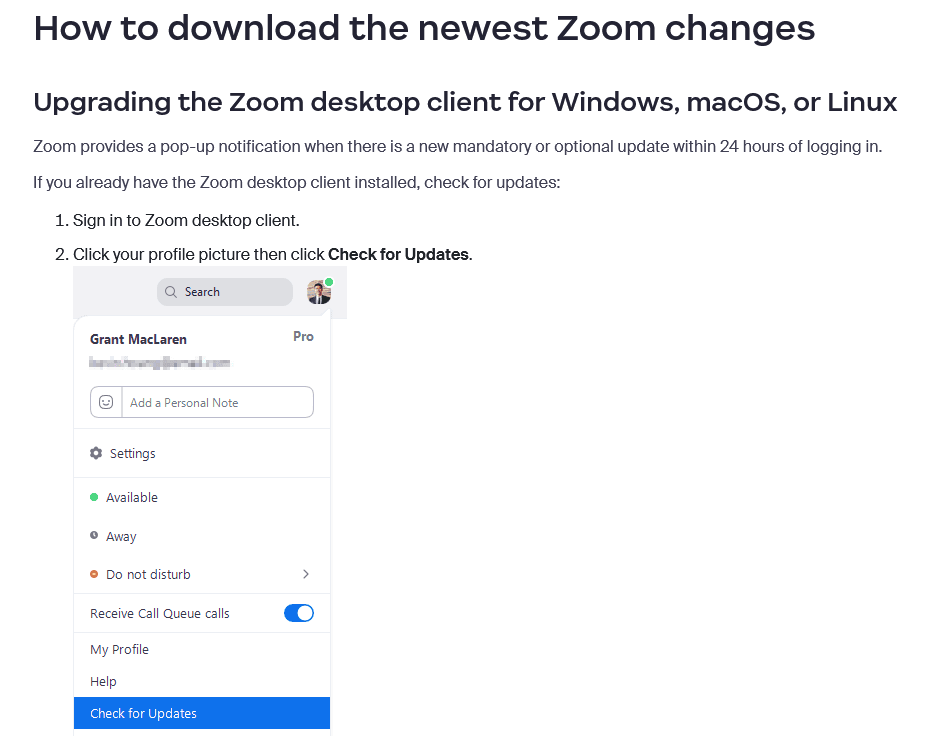
Source: Zoom
Combining two different resources—the release notes and the knowledge base—offers customers significant support.
In addition to the meticulous categorization and organization of release notes themselves, Zoom’s example contains some undoubtedly valuable and inspiring elements.
Conclusion
At a glance, it might seem like the product release notes aren’t a particularly important piece of technical documentation.
After all, they are essentially just a list of technical changes the product goes through, right?
Well, after reading this article and seeing the examples of what release notes can be, we certainly hope you don’t think the statements above are true.
Product release notes can be a versatile, appealing, and informative resource. The examples we’ve examined in this article can be a true inspiration, so all that is left is to get creative!
Frequently Asked Questions
The standout feature is the built-in subscription option, so you can get every update delivered automatically—by email or via RSS, Atom, or JSON feeds. Archbee also uses clear color-coded labels to show the type of change at a glance and includes a search bar to quickly find specific topics. Together, subscription, labeling, and search make staying up to date effortless.



